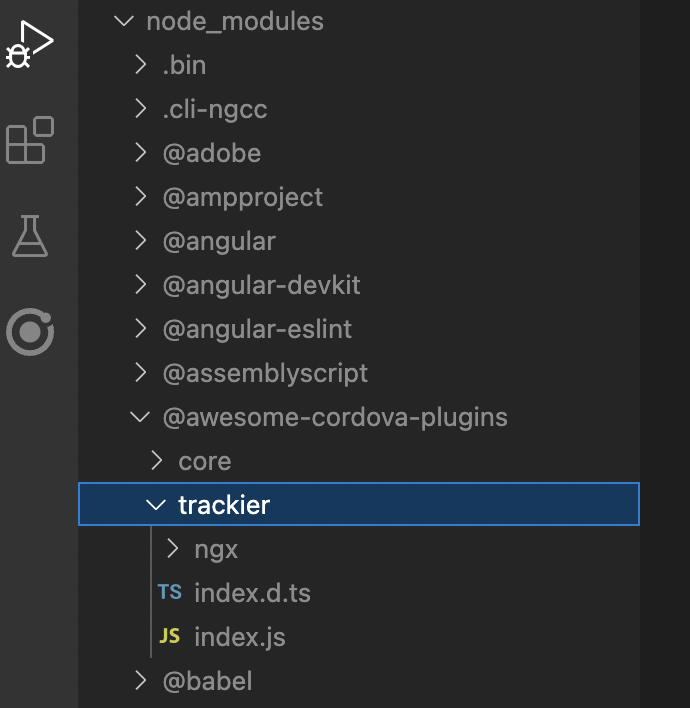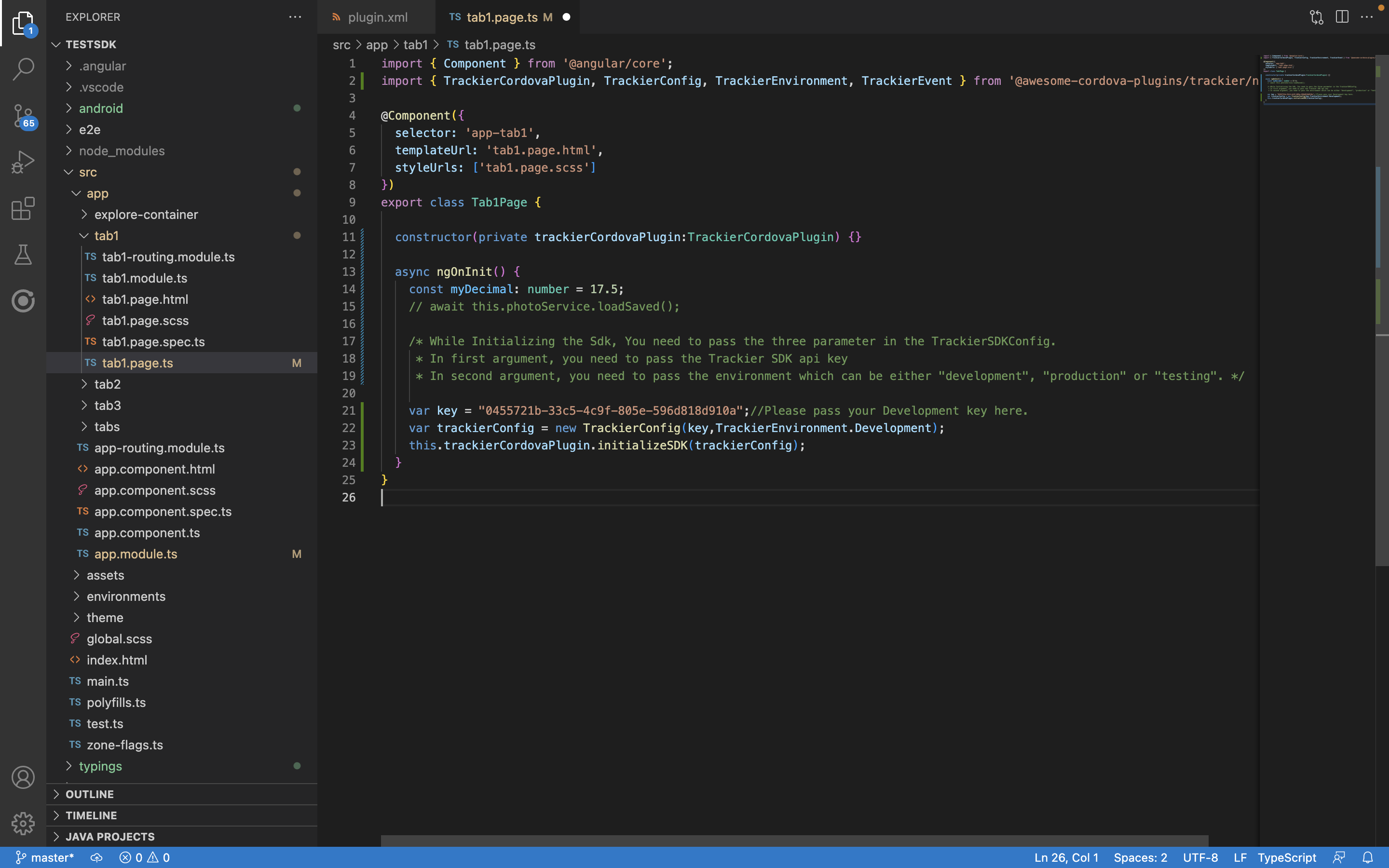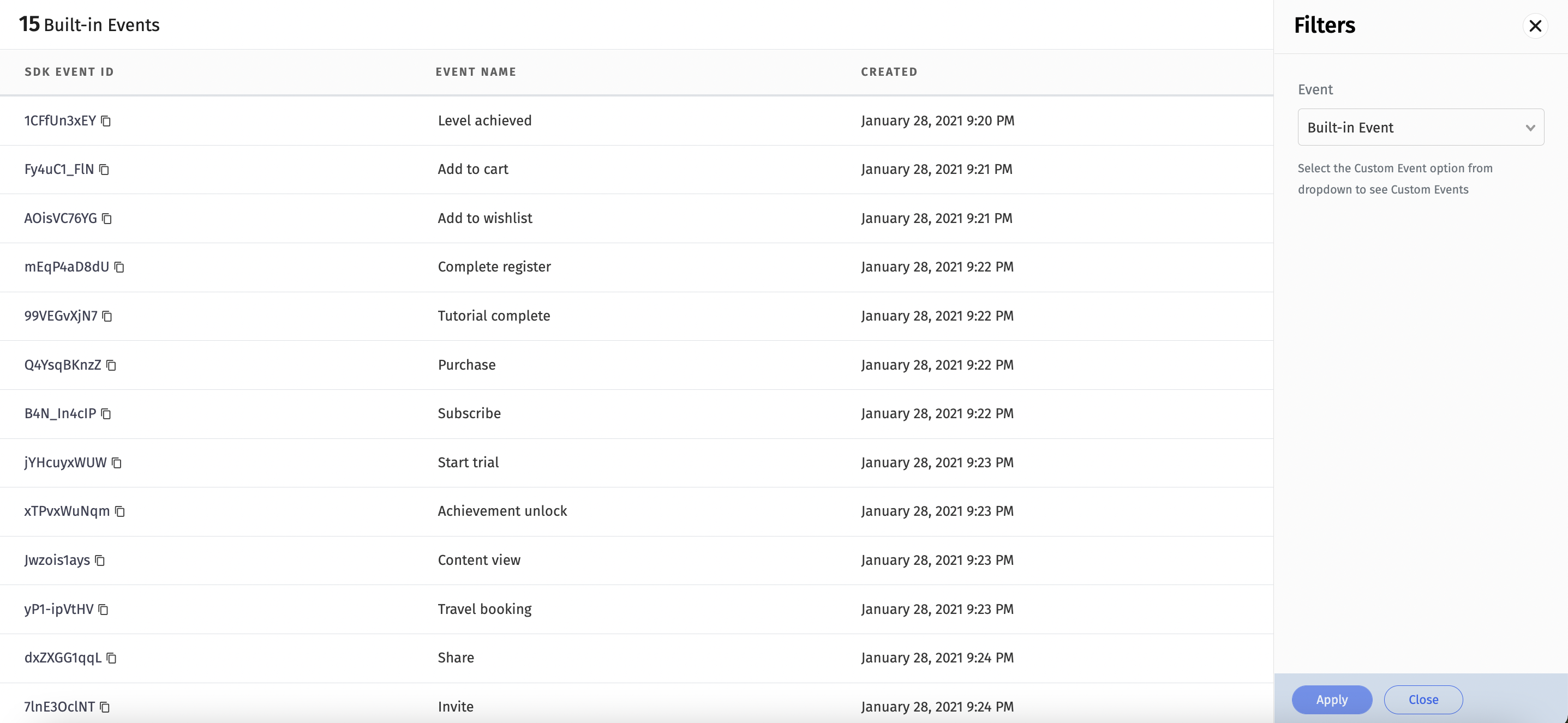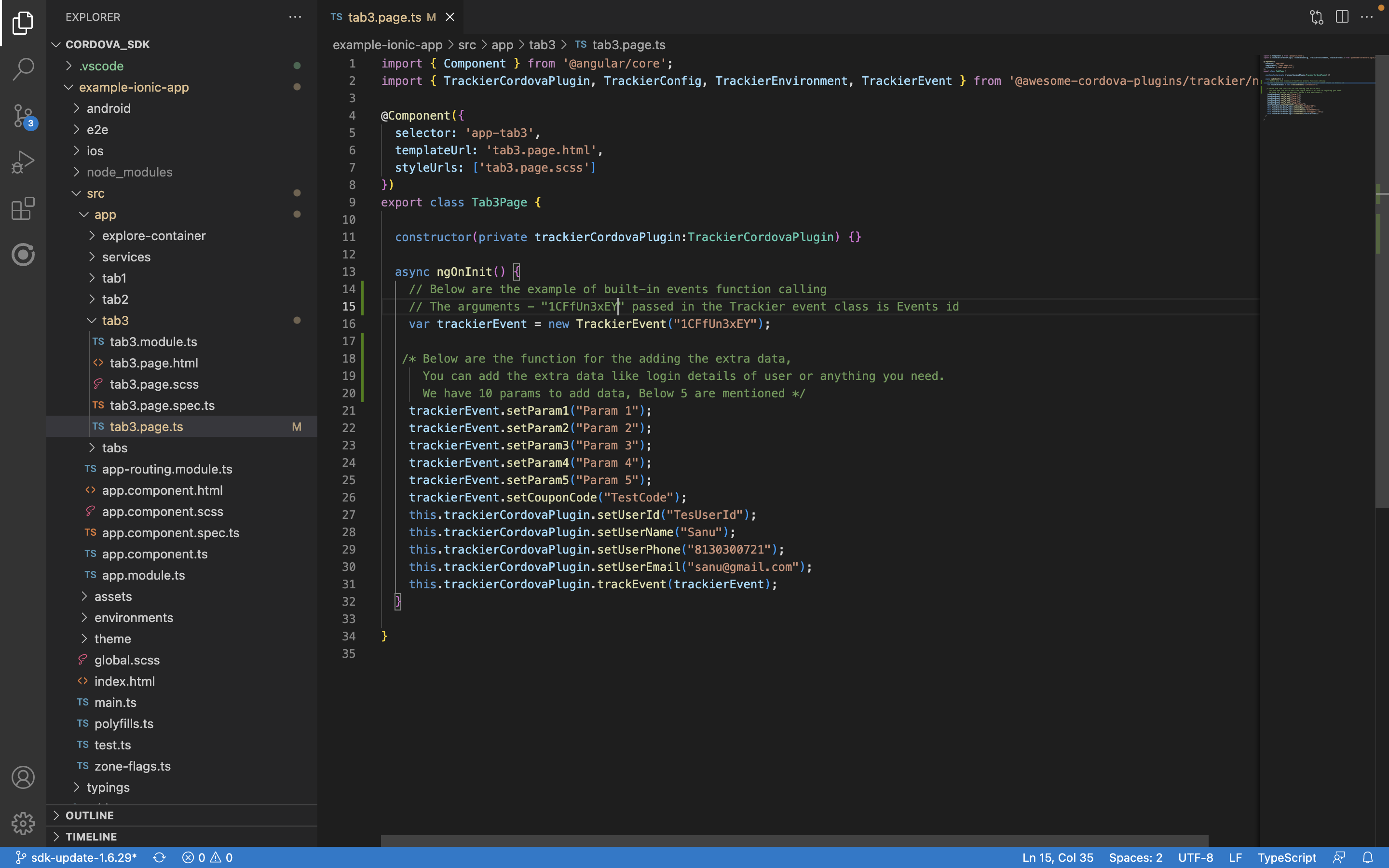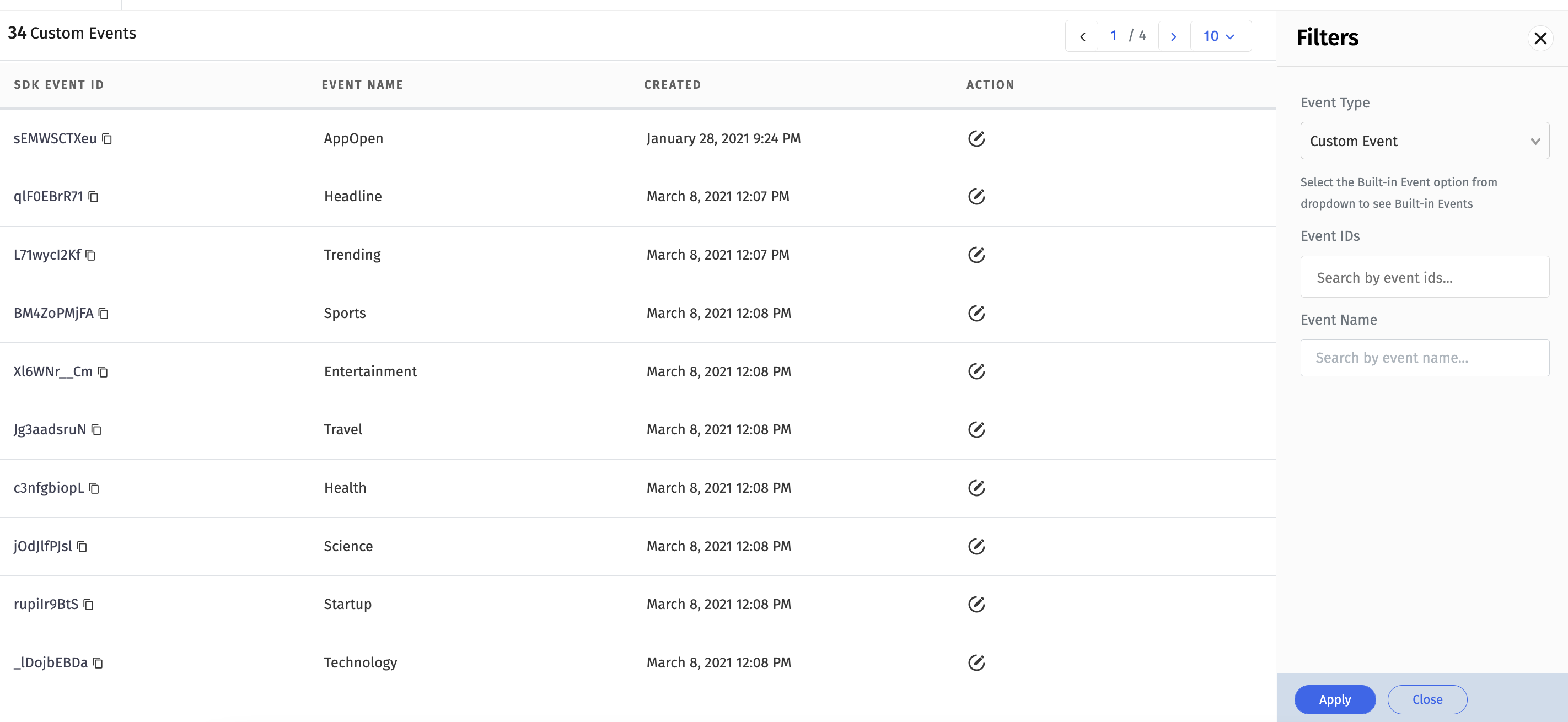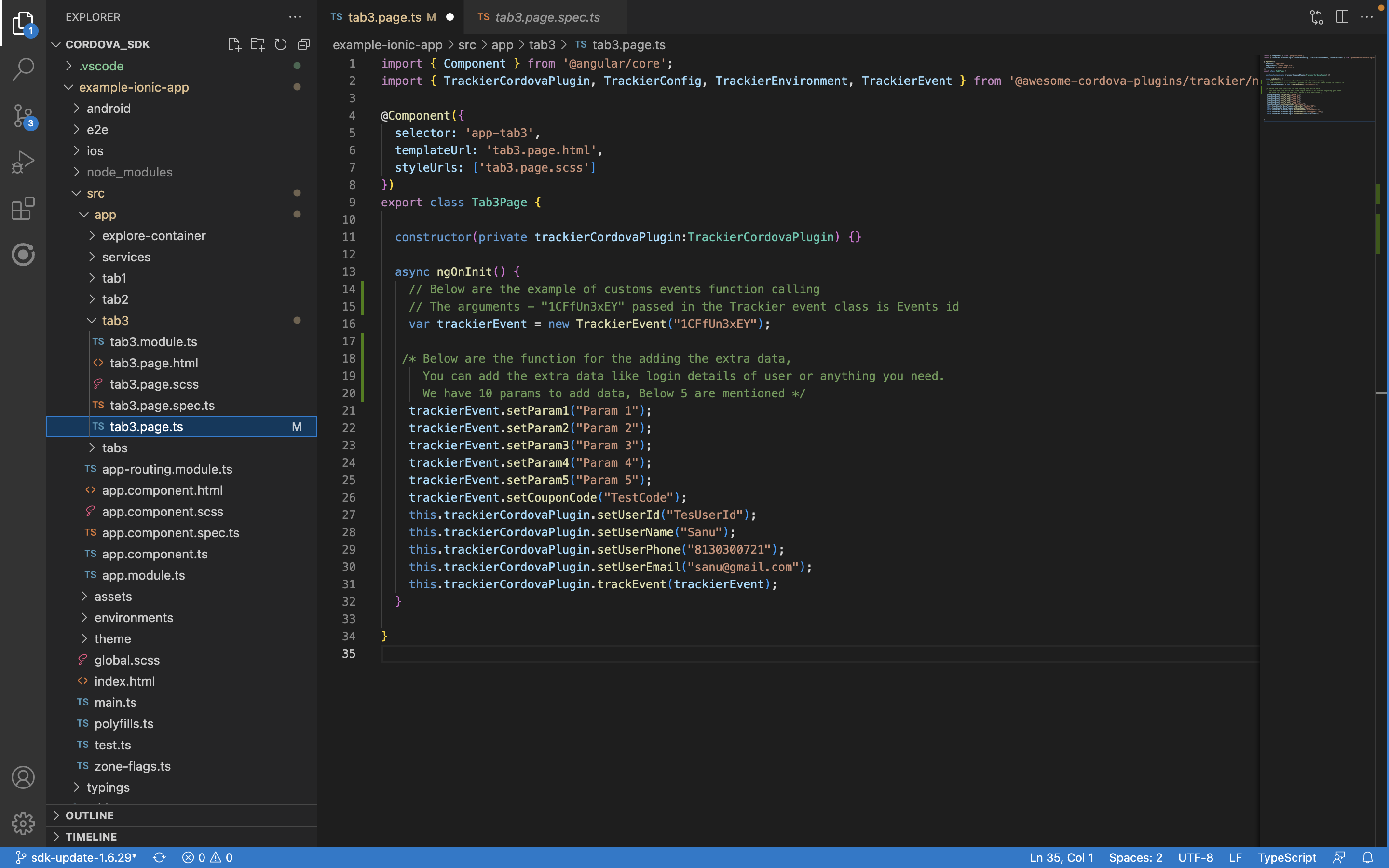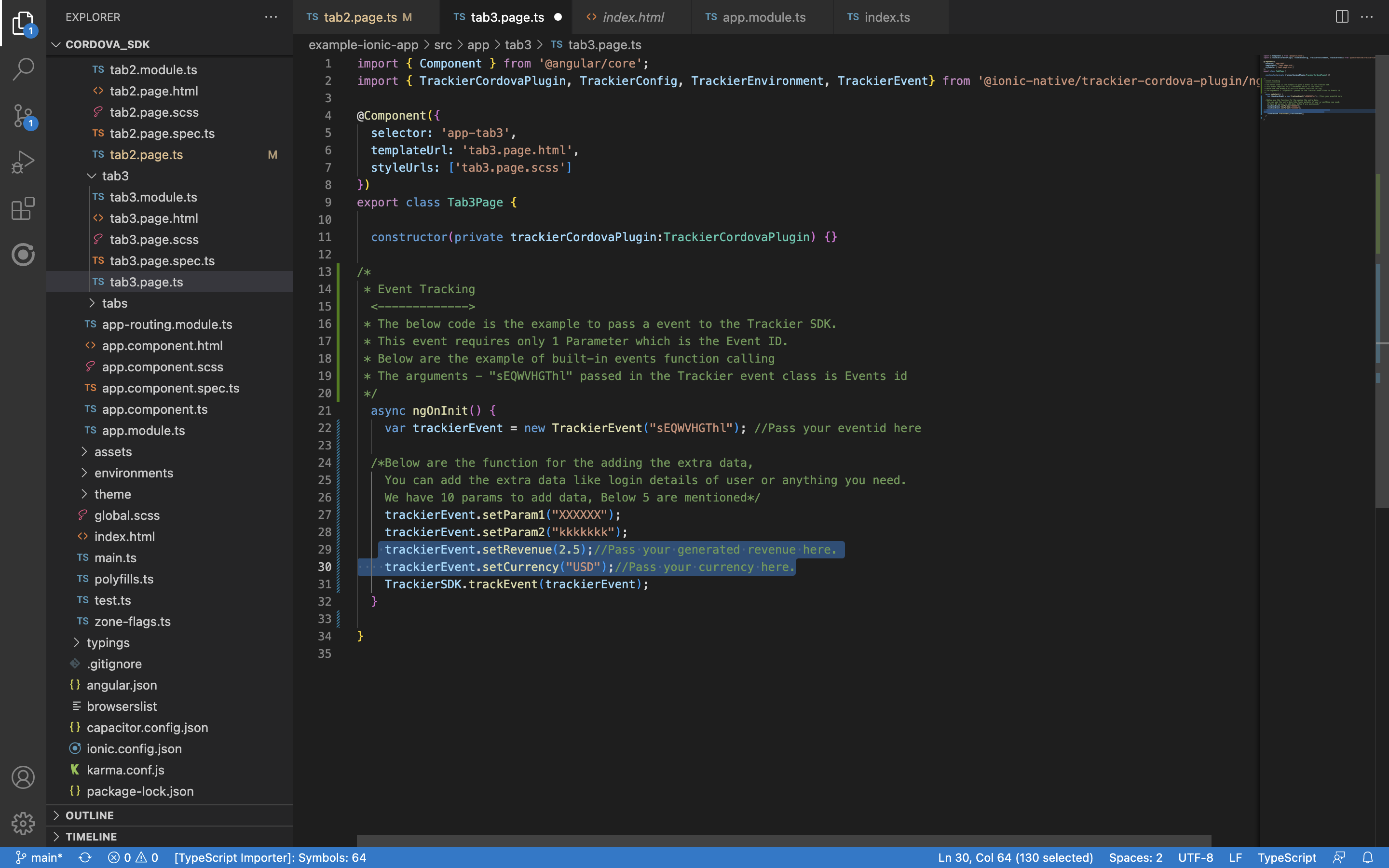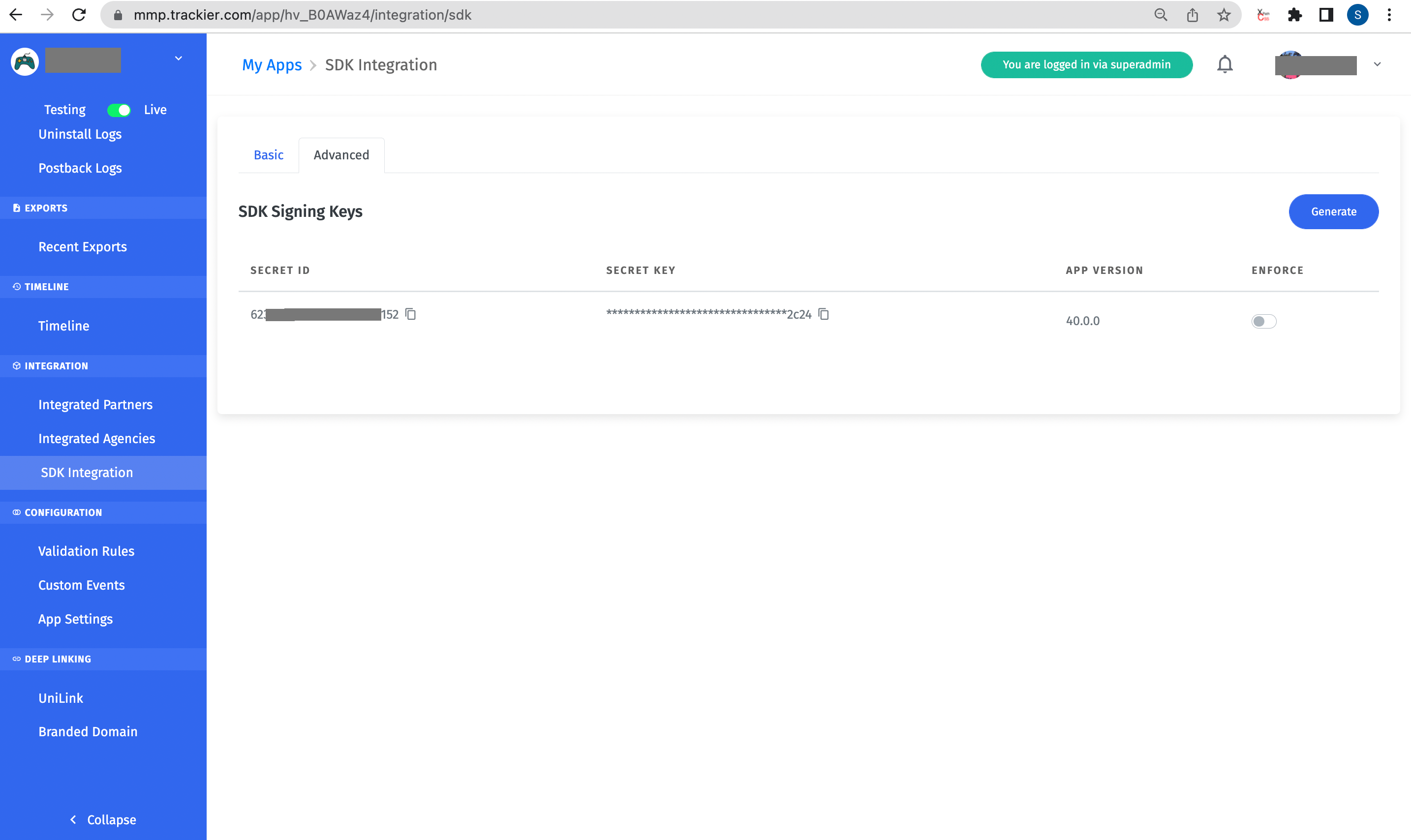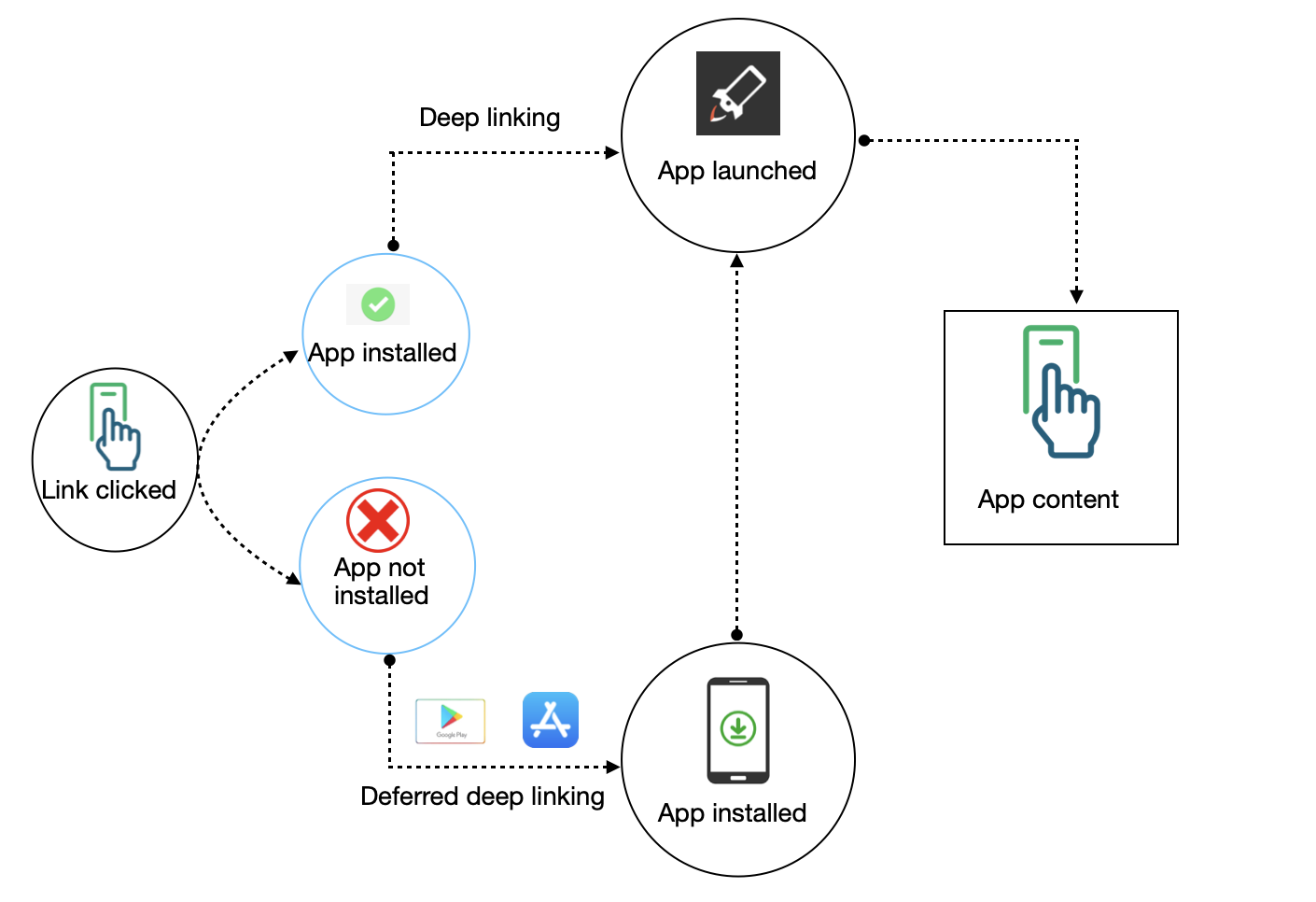- Quick start guide
- Integrate and Initialize the Trackier SDK
- Events Tracking
- SDK Signing
- Uninstall Tracking
- Getting Campaign Data
- Deep linking
- Proguard Settings
We have created a example app for the cordova sdk integration.
Please check the Example directory for know to how the Trackier SDK can be integrated.
Basic integration First, download the library from npm:
$ npm install trackier/cordova_sdk
In case you are using Ionic Native, Please follow the below steps for integration:-
- Install the the trackier cordova sdk by run the below commands in Terminal/Cmd.
$ npm install trackier/cordova_sdk
- You need to add the awesome cordova plugins by run the below commands in Terminal/Cmd.
$ npm install @awesome-cordova-plugins/core --save
- Run the below commands in Terminal/Cmd.
$ ionic cap sync
After following all the above steps, Please add the trackier folder in the the @awesome-cordova-plugins which is located in the node_modules.
You can download the trackier folder by the click on below link.
Link - https://github.com/trackier/cordova_sdk/releases/tag/1.6.49
Please check the below screenshots for the reference.
Your node_modules looks similar like above screenshots.
For initialising the Trackier SDk. First, We need to generate the Sdk key from the Trackier MMP panel.
Following below are the steps to retrieve your SDK key:-
- Login to your Trackier MMP account.
- Select the application from dashboard which you want to get the app token for.
- Go to SDK Integration via the left side navigation menu.
- Copy the SDK Key there to be used as the "app_token".
After following all the steps, Your SDK key should look like the below screenshot
Screenshot[1]
Add the Android Install Referrer as a dependency in your app build.gradle . You can find the latest version here
dependencies {
// make sure to use the latest SDK version:
implementation 'com.android.installreferrer:installreferrer:2.2'
}Trackier SDK need the following below permission in the AndroidManifest.xml
Please add the below permission in your app project AndroidManifest.xml. if they are not added.
<uses-permission android:name="android.permission.INTERNET" />
<uses-permission android:name="android.permission.ACCESS_NETWORK_STATE" />
<uses-permission android:name="android.permission.ACCESS_WIFI_STATE" />
<!-- Optional : -->
<uses-permission android:name="android.permission.READ_PHONE_STATE" />Trackier SDK need the advertising id from the application.
For achieving this, you need to add some line of code in the build.gradle and also in AndroidManifest.xml for read the Advertising id from the application which is mentioned below:-
- Add the google advertising id dependency in your android/app/build.gradle
dependencies {
// This can be added where the SDK dependency has been added
implementation 'com.google.android.gms:play-services-ads-identifier:18.0.1'
}- Update your Android Manifest file by adding the following permission. This is required if your app is targeting devices with android version 12+
<uses-permission android:name="com.google.android.gms.permission.AD_ID"/>- Add meta data inside the application tag (If not already added)
<meta-data
android:name="com.google.android.gms.version"
android:value="@integer/google_play_services_version" /> //Add this meta-data in the manifest.xml under Application tag.The Trackier SDK automatically registers with the Cordova events deviceready, resume and pause.
Depending on whether you build your app for testing or for production, you must set environment with one of these values:
TrackierEnvironment.Development
TrackierEnvironment.Production
TrackierEnvironment.Testing
In your index.js file after you have received the deviceready event, add the following code to initialize the Trackier SDK:
import { Component } from '@angular/core';
import { TrackierCordovaPlugin, TrackierConfig, TrackierEnvironment, TrackierEvent } from '@awesome-cordova-plugins/trackier/ngx';
@Component({
selector: 'app-tab1',
templateUrl: 'tab1.page.html',
styleUrls: ['tab1.page.scss']
})
export class Tab1Page {
constructor(private trackierCordovaPlugin:TrackierCordovaPlugin) {}
async ngOnInit() {
/* While Initializing the Sdk, You need to pass the three parameter in the TrackierSDKConfig.
* In first argument, you need to pass the Trackier SDK api key
* In second argument, you need to pass the environment which can be either "development", "production" or "testing". */
var key = "0455721b-XXXX-XXXXX-596d818d910a";//Please pass your Development key here.
var trackierConfig = new TrackierConfig(key,TrackierEnvironment.Development);
this.trackierCordovaPlugin.initializeSDK(trackierConfig);
}
}Also, you can the screenshot of example below:-
Screenshot[2]
In case you are using ionic native application:
1)Register the provider at app.module.ts:
You need to import the plugin and add the provider into app.module.ts, so add the import line and the provider in @NgModule:
import { NgModule } from '@angular/core';
import { BrowserModule } from '@angular/platform-browser';
import { RouteReuseStrategy } from '@angular/router';
import { IonicModule, IonicRouteStrategy } from '@ionic/angular';
import { AppRoutingModule } from './app-routing.module';
import { AppComponent } from './app.component';
import { TrackierCordovaPlugin} from '@ionic-native/trackier-cordova-plugin/ngx';
@NgModule({
declarations: [AppComponent],
entryComponents: [],
imports: [BrowserModule, IonicModule.forRoot(), AppRoutingModule],
providers: [TrackierCordovaPlugin,{ provide: RouteReuseStrategy, useClass: IonicRouteStrategy }],
bootstrap: [AppComponent]
})
export class AppModule {}Trackier events trackings enable to provides the insights into how to user interacts with your app. Trackier sdk easily get that insights data from the app. Just follow with the simple events integration process
Trackier provides the Built-in events and Customs events on the Trackier panel.
Predefined events are the list of constants events which already been created on the dashboard.
You can use directly to track those events. Just need to implements events in the app projects.
Screenshot[3]
import { Component } from '@angular/core';
import { TrackierCordovaPlugin, TrackierConfig, TrackierEnvironment, TrackierEvent } from '@awesome-cordova-plugins/trackier/ngx';
@Component({
selector: 'app-tab3',
templateUrl: 'tab3.page.html',
styleUrls: ['tab3.page.scss']
})
export class Tab3Page {
constructor(private trackierCordovaPlugin:TrackierCordovaPlugin) {}
async ngOnInit() {
// Below are the example of built-in events function calling
// The arguments - "1CFfUn3xEY" passed in the Trackier event class is Events id
var trackierEvent = new TrackierEvent("1CFfUn3xEY");
/* Below are the function for the adding the extra data,
You can add the extra data like login details of user or anything you need.
We have 10 params to add data, Below 5 are mentioned */
trackierEvent.setParam1("Param 1");
trackierEvent.setParam2("Param 2");
trackierEvent.setParam3("Param 3");
trackierEvent.setParam4("Param 4");
trackierEvent.setParam5("Param 5");
trackierEvent.setCouponCode("TestCode");
this.trackierCordovaPlugin.setUserId("TesUserId");
this.trackierCordovaPlugin.setUserName("Test");
this.trackierCordovaPlugin.setUserPhone("8130XXX721");
this.trackierCordovaPlugin.setUserEmail("[email protected]");
this.trackierCordovaPlugin.trackEvent(trackierEvent);
}
}Note:- Argument in Trackier event class is event Id.
You can integrate inbuilt params with the event. In-built param list are mentioned below:-
orderId, revenue, currency, param1, param2, param3 ,param4, param5, param6, param7, param8, param9, param10.
Below are the screenshot of following example
Screenshot[4]
Customs events are created by user as per their required business logic.
You can create the events in the Trackier dashboard and integrate those events in the app project.
Screenshot[5]
import { Component } from '@angular/core';
import { TrackierCordovaPlugin, TrackierConfig, TrackierEnvironment, TrackierEvent } from '@awesome-cordova-plugins/trackier/ngx';
@Component({
selector: 'app-tab3',
templateUrl: 'tab3.page.html',
styleUrls: ['tab3.page.scss']
})
export class Tab3Page {
constructor(private trackierCordovaPlugin:TrackierCordovaPlugin) {}
async ngOnInit() {
// Below are the example of customs events function calling
// The arguments - "1CFfUn3xEY" passed in the Trackier event class is Events id
var trackierEvent = new TrackierEvent("1CFfUn3xEY");
/* Below are the function for the adding the extra data,
You can add the extra data like login details of user or anything you need.
We have 10 params to add data, Below 5 are mentioned */
trackierEvent.setParam1("Param 1");
trackierEvent.setParam2("Param 2");
trackierEvent.setParam3("Param 3");
trackierEvent.setParam4("Param 4");
trackierEvent.setParam5("Param 5");
trackierEvent.setCouponCode("TestCode");
this.trackierCordovaPlugin.setUserId("TesUserId");
this.trackierCordovaPlugin.setUserName("Test");
this.trackierCordovaPlugin.setUserPhone("8130XXX721");
this.trackierCordovaPlugin.setUserEmail("[email protected]");
this.trackierCordovaPlugin.trackEvent(trackierEvent);
}
}Below are the screenshot of customs events calling
Screenshot[6]
Trackier allow user to pass the revenue data which is generated from the app through Revenue events. It is mainly used to keeping record of generating revenue from the app and also you can pass currency as well.
import { Component } from '@angular/core';
import { TrackierCordovaPlugin, TrackierConfig, TrackierEnvironment, TrackierEvent } from '@awesome-cordova-plugins/trackier/ngx';
@Component({
selector: 'app-tab3',
templateUrl: 'tab3.page.html',
styleUrls: ['tab3.page.scss']
})
export class Tab3Page {
constructor(private trackierCordovaPlugin:TrackierCordovaPlugin) {}
async ngOnInit() {
// Below are the example of customs events function calling
// The arguments - "1CFfUn3xEY" passed in the Trackier event class is Events id
var trackierEvent = new TrackierEvent("1CFfUn3xEY");
/* Below are the function for the adding the extra data,
You can add the extra data like login details of user or anything you need.
We have 10 params to add data, Below 5 are mentioned */
trackierEvent.setParam1("Param 1");
trackierEvent.setParam2("Param 2");
trackierEvent.setParam3("Param 3");
trackierEvent.setParam4("Param 4");
trackierEvent.setParam5("Param 5");
trackierEvent.setCouponCode("TestCode");
trackierEvent.revenue(10.0);
trackierEvent.currency("INR");
this.trackierCordovaPlugin.trackEvent(trackierEvent);
}
}Below are the screenshot of example of revenue events
Screenshot[7]
Trackier allows to pass additional data like Userid, Email to SDK so that same can be correlated to the Trackier Data and logs.
Just need to pass the data of User Id, Email Id and other additional data to Trackier SDK function which is mentioned below:-
import { Component } from '@angular/core';
import { TrackierCordovaPlugin, TrackierConfig, TrackierEvent, TrackierEnvironment } from '@awesome-cordova-plugins/trackier/ngx';
@Component({
selector: 'app-tab2',
templateUrl: 'tab2.page.html',
styleUrls: ['tab2.page.scss']
})
export class Tab2Page {
constructor(private trackierCordovaPlugin: TrackierCordovaPlugin) { }
async ngOnInit() {
var trackierEvent = new TrackierEvent("1CFfUn3xEY");
trackierEvent.setCouponCode("TestCode");
this.trackierCordovaPlugin.setUserId("TestUserId");
this.trackierCordovaPlugin.setUserName("testName");
this.trackierCordovaPlugin.setUserPhone("XXXXXXX");
this.trackierCordovaPlugin.setUserEmail("[email protected]");
this.trackierCordovaPlugin.setDOB("12/1/2022");
this.trackierCordovaPlugin.setGender("Male");
this.trackierCordovaPlugin.trackEvent(trackierEvent);
}
}Following below are the steps to retrieve the secretId and secretKey :-
- Login your Trackier Panel and select your application.
- In the Dashboard, click on the
SDK Integrationoption on the left side of panel. - Under on the SDK Integration, click on the Advanced tab.
- Under the Advanced tab, you will get the secretId and secretKey.
Please check on the below screenshot
Screenshot[8]
Check below the example code for passing the secretId and secretKey to the SDK
import { Component, OnInit } from '@angular/core';
import { TrackierCordovaPlugin, TrackierConfig, TrackierEnvironment } from '@awesome-cordova-plugins/trackier/ngx';
@Component({
selector: 'app-tab1',
templateUrl: 'tab1.page.html',
styleUrls: ['tab1.page.scss']
})
export class Tab1Page {
constructor(private trackierCordovaPlugin: TrackierCordovaPlugin) {
}
async ngOnInit() {
// await this.photoService.loadSaved();
/*While Initializing the Sdk, You need to pass the three parameter in the TrackierSDKConfig.
* In first argument, you need to pass the Trackier SDK api key
* In second argument, you need to pass the environment which can be either "development", "production" or "testing". */
var key = "abcf2270-xxxx-xxxx-a2ae-34903c6e1d53";//Please pass your Development key here.//abcf2270-d94a-xxxx-xxxx-34903c6e1d53 //6eb549a7-d17c-42fa-b694-1487607e39d0
var trackierConfig = new TrackierConfig(key, TrackierEnvironment.Development);
trackierConfig.setAppSecret("659fb6f1xxxxxxxa29d46c9", "9258fcdb-a7a7-xxxxx-xxxx-65835ed38407");
this.trackierCordovaPlugin.initializeSDK(trackierConfig);
}
}Trackier uninstall functionality is used to track the uninstall of the application from the devices. It is very useful for tracking the quality of the user.
this.trackierCordovaPlugin.getTrackierId().then(val =>
FirebaseAnalytics.setUserProperty({ name: "ct_objectId", value: val, }))
.catch(e => console.log('error: ', e)); // Replace this with your actual method to get ct_objectId- Add the above code to your app to set up a common identifier.
- Set the
app_removeevent as a conversion event in Firebase. - Use the Firebase cloud function to send uninstall information to Trackier MMP.
- You can find the support article here.
For getting the campaign data, We have a function that return the campaign data. Please check below the example code.
async ngOnInit() {
var trackierEvent = new TrackierEvent("1CFfUn3xEY");
//Campaign Data Methods
this.trackierCordovaPlugin.getTrackierId().then(val => console.log('===trackierid-: ', val)).catch(e => console.log('error: ', e));
this.trackierCordovaPlugin.getAd().then(val => console.log('getAd', val)).catch(e => console.log('error: ', e));
this.trackierCordovaPlugin.getAdID().then(val => console.log('getAdID', val)).catch(e => console.log('error: ', e));
this.trackierCordovaPlugin.getCampaign().then(val => console.log('getCampaign', val)).catch(e => console.log('error: ', e));
this.trackierCordovaPlugin.getCampaignID().then(val => console.log('getCampaignID', val)).catch(e => console.log('error: ', e));
this.trackierCordovaPlugin.getAdSet().then(val => console.log('getAdSet', val)).catch(e => console.log('error: ', e));
this.trackierCordovaPlugin.getAdSetID().then(val => console.log('getAdSetID', val)).catch(e => console.log('error: ', e));
this.trackierCordovaPlugin.getChannel().then(val => console.log('getChannel', val)).catch(e => console.log('error: ', e));
this.trackierCordovaPlugin.getP1().then(val => console.log('getP1', val)).catch(e => console.log('error: ', e));
this.trackierCordovaPlugin.getP2().then(val => console.log('getP2', val)).catch(e => console.log('error: ', e));
this.trackierCordovaPlugin.getP3().then(val => console.log('getP3', val)).catch(e => console.log('error: ', e));
this.trackierCordovaPlugin.getP4().then(val => console.log('getP4', val)).catch(e => console.log('error: ', e));
this.trackierCordovaPlugin.getP5().then(val => console.log('getP5', val)).catch(e => console.log('error: ', e));
this.trackierCordovaPlugin.getClickId().then(val => console.log('getClickId', val)).catch(e => console.log('error: ', e));
this.trackierCordovaPlugin.getDlv().then(val => console.log('getDlv', val)).catch(e => console.log('error: ', e));
this.trackierCordovaPlugin.getPid().then(val => console.log('getPid', val)).catch(e => console.log('error: ', e));
this.trackierCordovaPlugin.getIsRetargeting().then(val => console.log('getIsRetargeting', val)).catch(e => console.log('error: ', e));
this.trackierCordovaPlugin.trackEvent(trackierEvent);
}Deep linking is a techniques in which the user directly redirect to the specific pages of the application by click on the deeplink url.
There are two types deeplinking
-
Normal deeplinking - Direct deep linking occurs when a user already has your app installed on their device. When this is the case, the deep link will redirect the user to the screen specified in the link.
-
Deferred deeplinking - Deferred deep linking occurs when a user does not have your app installed on their device. When this is the case, the deep link will first send the user to the device app store to install the app. Once the user has installed and opened the app, the SDK will redirect them to the screen specified in the link.
Please check below the Deeplinking scenario
If a user already has your app on their device, it will open when they interact with a tracker containing a deep link. You can then parse the deep link information for further use. To do this, you need to choose a desired unique scheme name.
You can set up a specific activity to launch when a user interacts with a deep link. To do this:
- Assign the unique scheme name to the activity in your AndroidManifest.xml file.
- Add the intent-filter section to the activity definition.
- Assign an android:scheme property value with your preferred scheme name.
For example, you could set up an activity called FirstActivity to open like this:
<activity
android:name=".Activity.FirstProduct"
android:exported="true">
<intent-filter>
<action android:name="android.intent.action.VIEW" />
<category android:name="android.intent.category.DEFAULT" />
<category android:name="android.intent.category.BROWSABLE" />
<data
android:host="trackier.u9ilnk.me"
android:pathPrefix="/product"
android:scheme="https" />
</intent-filter>
</activity>
https://trackier.u9ilnk.me/product?dlv=FirstProduct&quantity=10&pid=sms
There is a Universal Links iOS app opening method which needs to be implemented for deeplink to work. This method directly opens the mobile app at default activity. Universal links take the format of normal web links for example. https://yourbrand.com or https://yourbrand.u9ilnk.me
Follow the steps for configuring Universal Links
a. Getting the app bundle ID and prefix ID
- Log into your Apple Developer Account.
- On the left-hand menu, select Certificates, IDs & Profiles.
- Under Identifiers, select App IDs.
- Click the relevant app.
- Copy the prefix ID and app bundle ID and insert in app settings page in Trackier MMP.
Screenshot[9]
b. Adding the prefix ID and app bundle ID in the Trackier MMP.
- Login your Trackier Panel
- Select your application and click on Action button and login as
- In the Dashboard, Click on the
UniLinkoption on the left side of panel. - On the Unilink page, create template by click on Action button which is located on the right side header of the page.
- After creating template, Edit that template by click on the edit button.
- On the edit template page, Add the prefix ID and app bundle ID in the Link Behaviour (When application is installed)
Please check the screenshot for the reference
Screenshot[10]
c. Configure mobile apps to register associated domains
Configuring mobile apps to register approved domains takes place inside Xcode. It requires the unilink subdomain that you can get from app setting page in Trackier MMP.
- Follow this iOS instructions
- Get the unilink subdomain from app settings page in Trackier MMP.
- In Xcode, click on your project. Click on the project target.
- Switch to Capabilities tab.
- Turn on Associated Domain.
- Add the unilink subdomain that you got from Trackier MMP.
- The format is applinks:subdomain.unilink.me. Add applinks: before the domain as like
applinks:subdomain.unilink.me
Screenshot[11]
To associate a domain with your app, you need to have the associated domain file on your domain and the appropriate entitlement in your app. Once the unilink is created, Trackier hosts the apple-app-site-association file. When a user installs your app, the system attempts to download the associated domain file and verify the domains in your Associated Domains Entitlement.
If your app is using proguard then add these lines to the proguard config file
-keep class com.trackier.sdk.** { *; }
-keep class com.google.android.gms.common.ConnectionResult {
int SUCCESS;
}
-keep class com.google.android.gms.ads.identifier.AdvertisingIdClient {
com.google.android.gms.ads.identifier.AdvertisingIdClient$Info getAdvertisingIdInfo(android.content.Context);
}
-keep class com.google.android.gms.ads.identifier.AdvertisingIdClient$Info {
java.lang.String getId();
boolean isLimitAdTrackingEnabled();
}
-keep public class com.android.installreferrer.** { *; }
